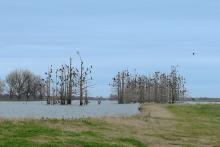Information Possibly Outdated
The information presented on this page was originally released on November 25, 2015. It may not be outdated, but please search our site for more current information. If you plan to quote or reference this information in a publication, please check with the Extension specialist or author before proceeding.
Double-crested cormorants wreak havoc on catfish
STARKVILLE, Miss -- It’s a duck, it’s a goose...no, it’s a Cormorant?
The double-crested cormorant is a 4- to 6-pound bird with black or dark plumage. Often cormorants are mistaken for common waterfowl because they are seen swimming on ponds and lakes throughout Mississippi from late fall to early spring. Cormorants migrate each year from the Great Lakes region of the U.S. and Canada to spend their winters on the warm waters of the South. They really are snow birds!

Unlike ducks and geese, which are largely herbivorous, the cormorant is a meat eater and a very skilled predator. Cormorants have webbed feet, long necks and long, hooked bills that enable them to catch their prey, primarily fish.
Similar cormorant species in Japan and China have been used by humans to catch fish. A fisherman will capture a cormorant, tie a string to the boat and to the bird’s foot, and put a ring around the cormorant’s neck so it can’t swallow larger fish. The captive cormorant will dive into the water and return to the surface with a fish that is retrieved by the fisherman.
Cormorants capture and consume fish measuring 3 to 15 inches long, but most are about 6 inches. They consume from 1 to 1.5 pounds of fish per day, which has been shown to negatively impact some fish populations if cormorants are too numerous.
Cormorants not only spend the winter in Mississippi for the warm weather, but also for the catfish. I’m not talking about those delicious fillets that have been breaded and cooked in peanut oil. Cormorants come for Mississippi’s farm-raised catfish.
The farm-raised catfish industry in Mississippi’s Delta and Black Belt regions represent more than 50 percent of the catfish production in the U.S. As you might expect, making fish production efficient means growing fish at very high densities, similar to growing corn, soybean or any other crop. While this approach makes feeding and harvesting catfish more efficient, it also makes the perfect hunting ground for the cormorant -- like catching fish in a barrel.
This abundance of food attracts cormorants to the aquaculture ponds, instead of the natural lakes and rivers where cormorants typically hunt. A single catfish farm can have thousands of cormorants hunting in its ponds, which can cause devastating financial losses.
A study conducted by the U.S. Department of Agriculture determined that cormorants consumed from 1,500 to 1,900 tons of catfish each year, which results in $5 to $12 million in economic losses to Mississippi catfish producers. But these birds are protected by the Migratory Bird Treaty Act and can’t be hunted like other species of waterfowl unless the farmer is given a special permit from the U.S. Fish and Wildlife Service. So what are the management solutions? How can catfish aquaculture and cormorants coexist?
Wildlife biologists and catfish producers have developed some techniques to reduce this economic loss by dispersing birds from aquaculture facilities. Some techniques are more effective than others. Frightening devices, like sound cannons, can be effective for a short period of time, but cormorants eventually get used to the noise and aren’t scared away.
USDA’s Wildlife Services has coordinated large-scale roost dispersals that have proven to be effective. A roost is a location where large groups of cormorants spend the night, usually in a cluster of trees. However, this technique requires a lot of manpower and time to constantly frighten birds away from the roost. Time is one thing most of our agricultural producers have little of.
The USDA, Wildlife Services, National Wildlife Research Center and Mississippi State University Extension Service are investigating the behavior of cormorants that roost near aquaculture facilities to learn more about why the birds appear to select certain ponds to hunt in.
To the human eye, many of the ponds look just alike, but cormorants show strong selection for certain ponds. If researchers can determine why cormorants are hunting in certain ponds and not others, maybe catfish producers can implement management strategies to make all their ponds less appealing to cormorants. Let’s keep our fingers crossed we can find solutions to this very important wildlife management issue.

Editor’s Note: Extension Outdoors is a column authored by several different experts in the Mississippi State University Extension Service.






